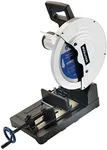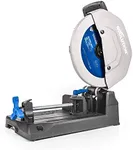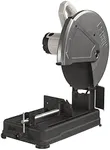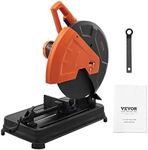Buying Guide for the Best Metal Chop Saws
Choosing the right metal chop saw can make your metalworking projects safer, faster, and more precise. Before you buy, think about the types of materials you'll be cutting, how often you'll use the saw, and the kind of cuts you need to make. Understanding the key features will help you match a saw to your needs, ensuring you get a tool that's both effective and comfortable to use.Blade SizeBlade size refers to the diameter of the cutting blade, usually measured in inches. This is important because it determines the maximum thickness and size of material you can cut in one pass. Smaller blades (around 10 inches) are suitable for lighter, thinner materials and more precise work, while larger blades (14 inches or more) can handle thicker, tougher metals. If you mostly work with small pipes or rods, a smaller blade may be enough, but for larger stock or frequent heavy-duty use, a bigger blade is better.
Motor PowerMotor power, usually measured in amps or watts, tells you how strong the saw is and how easily it can cut through tough metals. Lower-powered motors are fine for occasional use and thin materials, but if you plan to cut thick or hard metals regularly, a higher-powered motor will make the job easier and prevent the saw from bogging down. Think about the hardest material you expect to cut and choose a motor that can handle it without struggling.
Cutting CapacityCutting capacity describes the maximum size and shape of material the saw can cut, including both the width and height. This is important because it limits what you can work with. Saws with larger cutting capacities can handle bigger pipes, bars, or angles, while smaller capacities are fine for lighter work. Consider the largest pieces you expect to cut and make sure the saw can accommodate them.
Type of Blade (Abrasive vs. Carbide-Tipped)Metal chop saws use either abrasive blades or carbide-tipped blades. Abrasive blades are like thick grinding wheels and are good for general-purpose cutting, but they wear down quickly and can create a lot of sparks and heat. Carbide-tipped blades stay sharp longer, cut faster, and make cleaner cuts with less heat, but they are more expensive. If you need smooth, precise cuts or will use the saw often, a carbide-tipped blade is a good choice. For occasional or rough work, abrasive blades may be enough.
Adjustable Fence and Miter CapabilityThe fence holds your material steady and can sometimes be adjusted to make angled (miter) cuts. This is important if you need to cut pieces at different angles for frames or joints. Some saws have fences that can be set to common angles like 45 degrees, while others are fixed at 90 degrees. If you plan to do a lot of angled cuts, look for a saw with an easy-to-adjust, sturdy fence.
Safety FeaturesSafety features like blade guards, spark deflectors, and lock-off switches help protect you while using the saw. These are important for preventing accidents, especially if you’re new to using power tools. Look for saws with clear, well-designed safety features, and make sure you feel comfortable operating them.
Portability and Build QualityPortability refers to how easy it is to move the saw around, which is important if you need to use it in different locations. Build quality affects how long the saw will last and how well it stands up to tough jobs. Heavier, sturdier saws are more stable and durable, but lighter models are easier to carry. Think about where you’ll use the saw most and whether you need to move it often.











